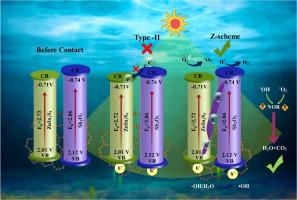太阳能驱动的双功能Z-scheme ZnIn2S4-Sb2O3在活性炭上支持,同时生成H2和诺氟沙星降解:机制,分析表征和毒性评估
IF 6.3
2区 材料科学
Q2 CHEMISTRY, PHYSICAL
引用次数: 0
摘要
光催化是一种很有前途的绿色技术,通过利用太阳能驱动氧化还原反应来解决环境修复和清洁能源生产。z型异质结的构建可以有效地利用太阳光谱,实现光生载流子的空间分离,并保持强氧化和还原电位。本文通过多步法合成了一种负载在活性炭上的ZnIn2S4-Sb2O3复合材料(ZISB-AC),并对其同时可见光驱动的H₂生成和诺氟沙星降解进行了评价。优化后的ZISB-0.2C在120 min内的NOR去除率达到97.1%,生成H的速率为732 μmol g⁻¹H⁻¹。光学(UV-vis DRS, PL, TRPL)和电化学(EIS,瞬态光电流)分析证实,与原始材料相比,电子-空穴复合受到抑制,电荷输运得到改善。自由基捕获和ESR实验显示•O₂⁻和•OH是主要的反应物质,验证了直接的Z-scheme电荷转移途径。通过LC-MS分析进一步阐明了光催化降解机制,确定了转化中间体并启动了途径构建。使用T.E.S.T.软件对这些中间体的毒性进行了评估,结果显示光催化后急性毒性和发育毒性均显著降低。稳定性和可回收性评估表明,在连续5个循环中,活性损失可以忽略不计,XPS证实了表面成分和化学状态的保存,强调了ZISB-AC复合材料在可持续环境和能源应用中的坚固性和长期适用性。本文章由计算机程序翻译,如有差异,请以英文原文为准。

Solar-driven dual-functional Z-scheme ZnIn2S4–Sb2O3 supported on activated carbon for simultaneous H2 generation and norfloxacin degradation: Mechanism, analytical characterization, and toxicity assessment
Photocatalysis represents a promising green technology for addressing both environmental remediation and clean energy production by harnessing solar energy to drive redox reactions. The construction of Z-scheme heterojunctions enables efficient utilization of the solar spectrum, spatial separation of photogenerated charge carriers, and preservation of strong oxidative and reductive potentials. Herein, a ZnIn2S4–Sb2O3 supported on activated carbon (ZISB–AC) composite was synthesized via a multi-step approach and evaluated for simultaneous visible-light-driven H₂ production and norfloxacin degradation. The optimized ZISB–0.2C achieved a high NOR removal efficiency of 97.1% within 120 min and an H₂ generation rate of 732 μmol g⁻¹ h⁻¹. Optical (UV–vis DRS, PL, TRPL) and electrochemical (EIS, transient photocurrent) analyses confirmed suppressed electron–hole recombination and improved charge transport compared to pristine counterparts. Radical trapping and ESR experiments revealed •O₂⁻ and •OH as the primary reactive species, validating the proposed direct Z-scheme charge transfer pathway. The photocatalytic degradation mechanism was further elucidated through LC–MS analysis, which identified transformation intermediates and enabled pathway construction. The toxicity of these intermediates was assessed using the T.E.S.T. software, revealing a significant reduction in both acute and developmental toxicity after photocatalysis. Stability and recyclability assessments demonstrated negligible activity loss over five consecutive cycles, with XPS confirming the preservation of surface composition and chemical states, underscoring the robustness and long-term applicability of the ZISB–AC composite for sustainable environmental and energy applications.
求助全文
通过发布文献求助,成功后即可免费获取论文全文。
去求助
来源期刊

Surfaces and Interfaces
Chemistry-General Chemistry
CiteScore
8.50
自引率
6.50%
发文量
753
审稿时长
35 days
期刊介绍:
The aim of the journal is to provide a respectful outlet for ''sound science'' papers in all research areas on surfaces and interfaces. We define sound science papers as papers that describe new and well-executed research, but that do not necessarily provide brand new insights or are merely a description of research results.
Surfaces and Interfaces publishes research papers in all fields of surface science which may not always find the right home on first submission to our Elsevier sister journals (Applied Surface, Surface and Coatings Technology, Thin Solid Films)
 求助内容:
求助内容: 应助结果提醒方式:
应助结果提醒方式:


